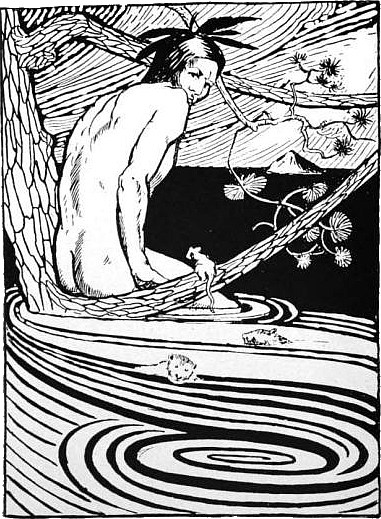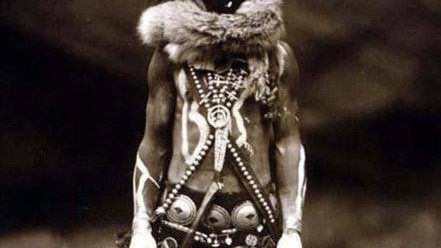Mythological Notes (II) - The Myth of the Werewolf - The figure of the werewolf in the Native American Myth
Introduction
In the last post we talk about the Greek myth of Lycaon, the king who unleashed the wrath of the gods with his human sacrifices, activity that, in the real life, was performed in the region that comprised the ancient Arcadia.
However, today we will make a huge jump from continent to continent. We leave Europe to go to America with the promise of coming back to her in the next post. We are going to the United States, with the Native people of such country. They have stories to tell about the werewolves.
The shape-shifters: Culture heroes and tricksters
Talking about the werewolves in the Native American mythology implies that we need to talk first about the shape-shifters, supernatural beings with the ability to adopt several animal and human forms, being that ability their own or granted by some god.
They are culture heroes, half human, ghalf gods or nature spirits, tending to help or harm the man. They're considered as founders of some people, of an activity or a ritual, and are even credited with a creative quality.
A representative example of these beings is Nanabozho.

Nanazboho in the flood. Ilustration of R.C. Armour.Wikipedia
Some versions indicate that this character was the West Wind's or the Sun's child with a human woman, who died in childbirth, and was the grandson of the wise woman Nokomis. While some versions indicate that he was the only child, others indicate that he was the eldest or the twin brother of Chibiabos, the king of the Underworld and whom the Ojibwa frequently associate with the wolves, for his kindness towards those who take good care of the dead.
As you can see, Nanabozho was considered as a trickster, although the Ojibwa also highlight several benign attributes, like the foundation of the Midewiwin, native name asigned to the group of traditional doctors called "Grand Society of Medicine", and the creator of fishing.
While adopting several animal and human forms, the Ojibwa associate him with rabbits, being it the most recurrent animal in the myths of the hero.
Nevertheless, as well as there are shape-shifters that are benign in nature, there are shape-shifters that, despite being kind to those who do good deeds, in the end they punish those who make severe errors with hardness, like the case of Wisakachek and the two brothers Keme and Matchitehew ... Or that simply seek to do harm, like the case of the Mai-cob or Yee-naaldloshii.
A mistake, a punishment: Wisakachek and the two brothers

Werewolf. Brighton Roleplayers
On the Cree and Navajo mythologies, Wisakachek, or Wisakedjak, was a forest spirit that adopted any animal form, usually a wolf. He was kind to those who helped him and terrible to those who offended him. The Cree considered him as a benign trickster.
One morning, Wisakacheck saw at two brothers in the forest, both named Keme and Matchitehew. Approaching them in his human guise, he asked them to gave him food and water, which both brothers agreed. As a reward for their generosity, Wisakachek grants them the power to transform into wolves at will, only on the condition of no harm to people. Fascinated by their new ability, and taking into account the condition imposed by the spirit, Keme and Matchitehew transformed into wolves during hunting for several months until one night, when Matchitehew wounded someone under his wolf form in the middle of a fight. The result for both young boys was devastating: they were expelled from the tribe with the fear on that they could do more damage (Ventura, 2013: 116).
Wisakachek, disappointed and furious, decided to give Matchitehew an exemplary punishment: during the nights he would transform into wolf, but would lose his humanity and would cede to his lethal instincts. As for Keme, Wisakachek allowed him to keep intact his humanity due to not having committed any damage; however, fearing that Matchitehew could not control himself already, he isolated himself in the forest (Ventura, 2013: 116).
Wolves and witchcraft: the Yee-naaldloshii

Picture of a yee-naaldloshii. Tumblr
With Matchitehew, the werewolves, or as the Navajo say, the Yee-naadloshii came. Also called "Mai-cob" and "skin-walkers", the Yee-noodloshii are humans who practice witchcraft with the purpose of causing harm. Their main ability was the tranformation into animals, being the wolf the the most recurrent figure in their transformations. There is no much information about these characters, except for what is mentioned in websites like Wikipedia, where is alleged that the Navajo themselves are very reluctant to talk about the subject.
Consulted sources
- Ventura, Varla. 2013. Banshees, Werewolves, and other creatures of the night: Fictions and first-hand accounts. San Francisco. Editorial Weiser Books. Consulted in: Google Books
- “Skin-walker”, in: https://en.wikipedia.org/wiki/Skin-walker Consulted on April 21st
- “Nanabozho”, “Chibiabos” y “Nokomis”, in: http://www.native-languages.org Consulted on April 21st.
I am passionate about mythological stories, in my country we have a legend of the seventh son man becomes Lobizon on Thursday to dawn Friday or full moon days, Our ancestors were very believers in this legend.
I really liked your work dear friend @vickaboleyn congratulations
¡Gracias, compañero! Había leído sobre el lobisón, o luisón, en la Wikipedia y espero que la siguiente semana después de ésta ya publique por aquí y en el blog los pormenores del relato. ¡Muchas gracias por tu aportación!
This post has been ranked within the top 10 most undervalued posts in the first half of Apr 23. We estimate that this post is undervalued by $3.10 as compared to a scenario in which every voter had an equal say.
See the full rankings and details in The Daily Tribune: Apr 23 - Part I. You can also read about some of our methodology, data analysis and technical details in our initial post.
If you are the author and would prefer not to receive these comments, simply reply "Stop" to this comment.